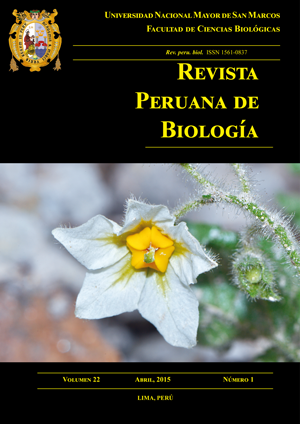Listado anotado de Solanum L. (Solanaceae) en el Perú
DOI:
https://doi.org/10.15381/rpb.v22i1.11121Palabras clave:
Andes tropicales, endemismo, patrones de diversidad, riqueza de especies.Resumen
Solanum L. es uno de los géneros que posee una alta riqueza de especies dentro de la flora peruana y dentro de los Andes tropicales en general. Presentamos una lista revisada de 276 especies de Solanum para el Perú, de estas 253 son nativas, mientras que 23 son introducidas y/o cultivadas. Un total de 74 especies de Solanum (29% de las especies nativas) son endémicas de Perú. Además 58 especies se encuentran solamente en pequeñas poblaciones fuera del Perú, y estas especies están designadas aquí como casi endémicas para destacar el rol importante del Perú en la futura protección de estas especies. El pico de diversidad de especies es observado entre 2500 – 3000 m de elevación, pero la diversidad de especies endémicas es más alta entre 3000 – 3500 m. Cajamarca tiene el más alto número de especies (130 spp.) y de especies endémicas (29 spp.), incluso si se considera el efecto del área. Centros de diversidad de especies endémicas se localizan en las provincias de Cajamarca (Cajamarca), Huaraz y Carhuaz (Ancash), Canta y Huarochirí (Lima). Centros de endemismos secundarios con una alta concentración tanto de especies endémicas y de casi endémicas se encuentran en San Ignacio y Cutervo (Cajamarca), Santiago de Chuco (La Libertad), Oxapampa (Pasco), y Cusco (Cusco): Los actuales patrones de diversidad están altamente correlacionados con la densidad de colecciones, por lo que es necesario una mayor colecta en todas las regiones, especialmente en Arequipa, Ayacucho, Puno, Ancash, Huánuco, Amazonas y Cajamarca, donde se indican altos niveles de diversidad y endemismo de especies, pero de las cuales existen pocas colecciones.Descargas
Descargas
Publicado
Número
Sección
Licencia
Derechos de autor 2015 Tiina Särkinen, Maria Baden, Paúl Gonzáles, Marco Cueva, Leandro L. Giacomin, David M. Spooner, Reinhard Simon, Henry Juárez, Pamela Nina, Johanny Molina, Sandra Knapp

Esta obra está bajo una licencia internacional Creative Commons Atribución-NoComercial-CompartirIgual 4.0.
LOS AUTORES RETIENEN SUS DERECHOS:
a. Los autores retienen sus derechos de marca y patente, y también sobre cualquier proceso o procedimiento descrito en el artículo.
b. Los autores retienen el derecho de compartir, copiar, distribuir, ejecutar y comunicar públicamente el artículo publicado en la Revista Peruana de Biología (por ejemplo, colocarlo en un repositorio institucional o publicarlo en un libro), con un reconocimiento de su publicación inicial en la Revista Peruana de Biología.
c. Los autores retienen el derecho a hacer una posterior publicación de su trabajo, de utilizar el artículo o cualquier parte de aquel (por ejemplo: una compilación de sus trabajos, notas para conferencias, tesis, o para un libro), siempre que indiquen su publicación inicial en la Revista Peruana de Biología (autores del trabajo, revista, volumen, número y fecha).






